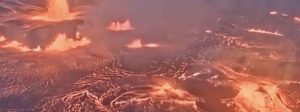The ground at the summit of Kilauea volcano in Hawaii has been rumbling and swelling in recent days, prompting scientists to warn that the mountain could once again disgorge lava. But there’s no indication an eruption is imminent. The volcano, which is among the world’s most active, has behaved similarly in the past without any magma breaking the surface.
Also read : Why do volcanoes erupt?
Here’s an overview of the latest developments at Kilauea:
WHAT ACTIVITY ARE SCIENTISTS SEEING?
Scientists at the Hawaiian Volcano Observatory on Monday noticed a surge of earthquakes and the ground swelling at the southern part of the crater at Kilauea’s summit. There are indications magma is shifting about a half-mile to a mile (1 to 2 kilometers) below the surface.
Watch: YouTuber captures stunning videos of Iceland’s volcano eruption
It’s not uncommon for Kilauea to have earthquakes, which could indicate rocks are moving. It’s also not unusual for the ground to swell as the heat from the sun and saturation from rain can cause the ground to expand and contract.
However, earthquakes and ground swelling at the same time may indicate magma is on the move.
“We get a lot of earthquakes here and we get a lot of deformation here, but the combination of the two makes us much more aware,” said Jefferson Chang, a geophysicist at the observatory, which is part of the U.S. Geological Survey.
There have been hundreds of earthquakes since Monday, striking as often as 25 times an hour. The strongest measured magnitude 3, with most coming in between magnitude 1 and 2 At these levels, the quakes are generally too small for people to notice. Chang said there haven’t been any reports of people feeling them.
Also Read: A look at Iceland’s recent volcanic eruptions
WHERE IS THE ACTIVITY HAPPENING?
It’s occurring at the summit of Kilauea volcano, an uninhabited area within Hawaii Volcanoes National Park on the Big Island. This is about 200 miles southeast of Honolulu, which is on a different island called Oahu
The site is miles from the nearest town. The park has close off this part of the summit to the public since 2008.
Ben Hayes, the park’s interpretation and education program manager, said the park is preparing for a potential eruption, but he said there’s nothing to be alarmed about. “It’s a natural process at one of the world’s most active volcanoes,” he said.
HAS THIS HAPPENED BEFORE?
Chang said scientists observed activity in the same part of the summit in 2015. That episode lasted three days, and the volcano didn’t erupt. Just like this time, the ground swelled. One difference is that there were more earthquakes then.
The last time Kilauea erupted at the southern part of its caldera or crater was in 1974.
Also Read: 45-feet ‘ice volcano’ builds out of natural springs in Kazakhstan’s Almaty region
WHAT’S THE CURRENT SITUATION?
The earthquake swarm stopped about 4:30 a.m. Monday. The ground swelling has also subsided. But the activity could return. Chang said sometimes there’s a lull in activity lasting a day or two.
WHAT DOES IT MEAN TO CHANGE THE ALERT LEVEL?
The observatory changed Kilauea’s volcano alert level to watch from advisory on Tuesday, meaning the mountain was showing heighted unrest with increased potential to erupt.
But scientists don’t know when that eruption may occur, if it does. If scientists believe a hazardous eruption is imminent, they will change the alert level to warning.
The observatory also changed the aviation color code to “orange,” alerting pilots that there’s potential for an eruption and they may need to avoid the area if one occurs.
HOW OFTEN HAS KILAUEA ERUPTED BEFORE?
Hawaiian chants and stories tell the stories of countless eruptions. In Hawaiian tradition, Kilauea is home to the volcano goddess Pele.
Kilauea has erupted 34 times since 1952. From 1983 to 2018, it erupted almost continuously, in some cases sending streams of lava that covered farms and homes. At the end of this decades-long eruption, Kilauea spewed lava from vents in a residential neighborhood on its eastern flank and destroyed more than 700 homes.
In December, Kilauea erupted at the crater, creating a lake with enough lava to fill 10 Hoover dams. That eruption ended in May.






